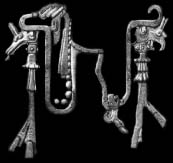Magic Melodies
author unknown
 The basic notion exists that ayahuasca teaches "magic melodies" known as
"icaros." In fact, being a vegetalista is almost synonymous with mastering a
vast repertiore of icaros - each of the different psychoactive plant spirits
has its own icaro. Different types of icaros serve a variety of purposes
ranging from love magic to divination to the cure of snakebite.
"Shirohuehua" or fun songs, for example, animate the patient, inducing joy
and hope. "Manchari" are sung to lead an abducted soul back to its owner.
With the "icaro de aranita," a little spider spins a web around a man and a
woman uniting them for all eternity.
The basic notion exists that ayahuasca teaches "magic melodies" known as
"icaros." In fact, being a vegetalista is almost synonymous with mastering a
vast repertiore of icaros - each of the different psychoactive plant spirits
has its own icaro. Different types of icaros serve a variety of purposes
ranging from love magic to divination to the cure of snakebite.
"Shirohuehua" or fun songs, for example, animate the patient, inducing joy
and hope. "Manchari" are sung to lead an abducted soul back to its owner.
With the "icaro de aranita," a little spider spins a web around a man and a
woman uniting them for all eternity.
Icaros are taught by the tutleary spirits of plants and animals: the raya-balsa, for example, an aquatic plant, can teach one to travel under the water. There are even icaros of perfumes, stones and resins. The "sirenas" or mermaids are often invoked in ayahuasca sessions. They appear, singing beautiful icaros, accompanied by string instruments. Their icaros can give one power over the underwater world, particularly over the Bufeo or pink river dolphin. These creatures are feared and seen as mighty sorcerers, yet they are also invested with sexual allure. Men are said to feel an intense pleasure during coitus with dolphins, and are sometimes unable to separate themselves.
Icaros are used only during ayahuasca sessions. There is a hierarchy among shamans depending on the number and power of the icaros they know. The icaros sung in Spanish are not as powerful as those in jungle Quechua; mixtures of Queschua with Cocama and Omagua are particularly potent. Yet each shaman has a principal icaro which represents the essence of his power.
In the highly sensitized state of ayahuasca intoxication, the icaros help structure the vision. They can also modify the hallucinations themselves. Luna reports: "There are icaros for increasing or diminishing the intensity and color of the visions, for changing the color percieved, and for directing the emotional contents of the hallucinations."
Vegetalistas are masters of synaesthesia. Through using the most interesting acoustic effects produced by whistling and singing, the geometric designs can be seen acoustically. The icaros refer to a medicine as "my painted song," "my words with those designs," or "my ringing pattern."
The icaros are the quintessence of shamanic power. A good vegetalista is able to "orchestrate" beautiful or transformative visions through his magic melodies. Competitions sometimes arise between maestros to "monopolize" the visions of those present - a kind of competitive "jam session" where they unleash all their tricks.
Luna has included musical transcriptions of eight icaros culled from the repertoire of his informant, Maestro Don Emilio, in Appendix II of his book. Luna describes some of the icaros as having great unearthly beauty and urges ethnomusicologists to record them soon, as they are an evanescent feature of shamanic culture, that is fast disappearing. True ayahuasqueros, he claims, are dying out and their roles are being assumed by charlatans. The key to recognizing a true maestro is: does he know the magic melodies?